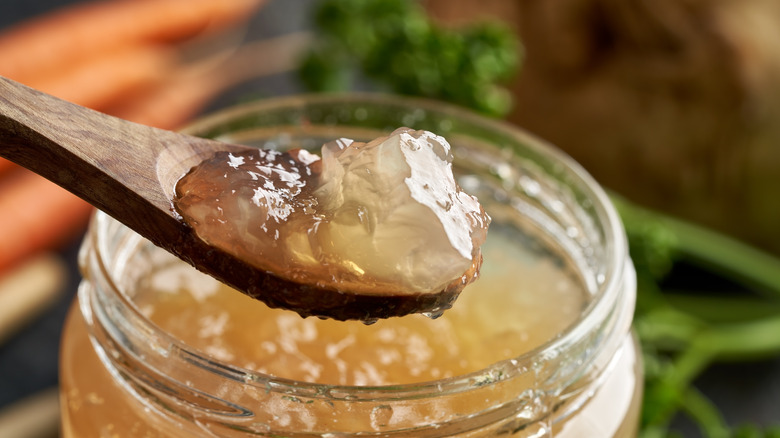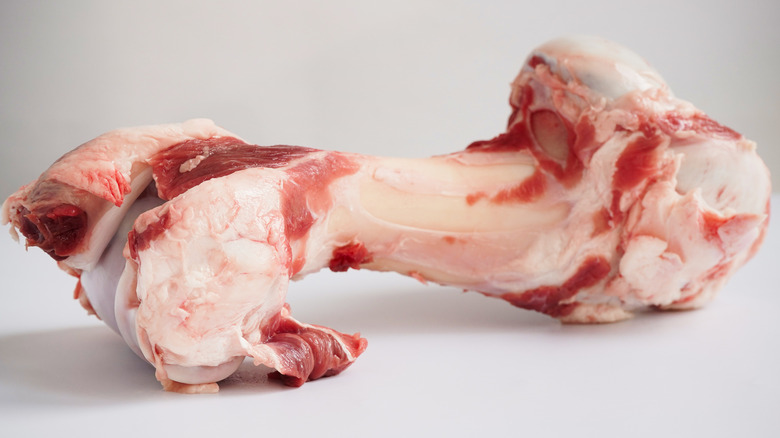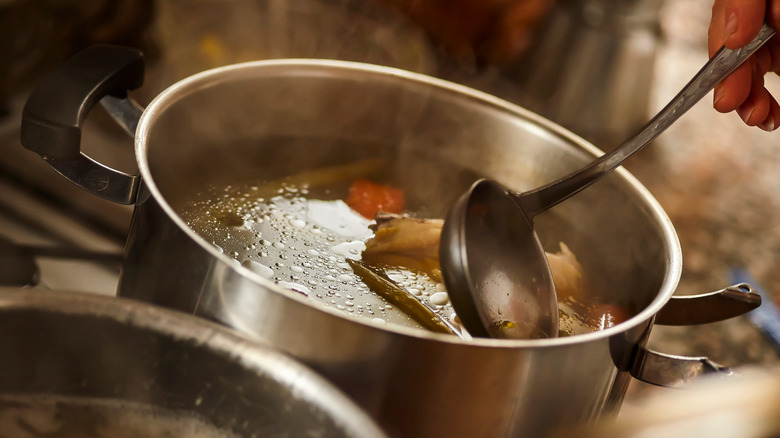Here's What To Do If Your Bone Broth Doesn't Gel
Bone broth is no trend, it's here to stay. According to The New York Times, "Broth made with plenty of bones contributes to well-being in ways that other foods don't." Sipping warm bone broth is an ancient answer to feeling under the weather. Now, we better understand how the collagen, amino acids, and minerals that are derived from bones offer a wide range of benefits to your health.
Many people are doing their own "broth-ing." Thankfully, making your own bone broth is a simple task. But, as is often the case when cooking, the easy things can sometimes be the hardest to master, like getting the perfect fried egg. Thin, watery bone broth probably tastes fine and will satisfy a thirsty broth enthusiast. But, for bone broth to reach its full potential, the gelatin needs to be coaxed from the bones in order to achieve an unctuous, wobbly, stick to your ribs broth.
The gelatin that enables rich bone broth comes from collagen, the tough, gristly bits that hold bones and muscles together. Simmer in enough water for enough time and collagen's protein coils unravel to become gelatin. Those protein strands reconnect as the liquid cools. Depending on the proportion of gelatin to water, it can be slightly viscous, a little jiggly, or almost solid.
The key to gelled bone broth
According to Nourished Kitchen, the best bone broth options are joints full of collagen-laden ligaments and tendons, in addition to the bones. Beef knuckles, chicken carcasses, and ox tails are great options. A mixture of animal bones can be a tasty step that will ensure enough gelatin to achieve gelled bone broth.
Only add water to cover the bones by two inches. Too much might dilute the gelatin to a point that it can't gel. Adding a splash of something acidic will help the collagen breakdown. Vinegar, wine, or tomato paste, like Matrtha Stewart uses, are good options. For a gallon of water, one tablespoon of these will suffice as you probably don't want vinegar-flavored bone broth. Bring all of this to a simmer. Higher temps will damage the gelatin and ruin its ability to gel the bone broth. Temps too low won't dissolve enough collagen. A simmer is ideal.
The right amount of time is harder to identify. The best guidelines are to use the size of the bones to determine the simmering time. As Nourished Kitchen tells us, small bones, like poultry, will only take four to 12 hours and large beef bones can simmer for up to 18 hours. That's enough time to maximize the amount of gelatin.
You can always add gelatin
If, after all of that, your bone broth isn't gelled, there's still hope. Store-bought gelatin is more than a 1950s and 60s-era fad. It's the cure for your watery broth. According to the Tampa Bay Times, you can add two envelopes of powdered gelatin to one cup of cool water. This step is called "blooming" and rehydrates the gelatin so that it can dissolve. Without this step, it could just clump up and you're left with thin, lumpy broth. Add the bloomed gelatin to six cups of broth in a pot. Stir and gently warm over medium heat to dissolve the gelatin. Allow this to cool and refrigerate.
This solidified broth will reliquify upon reheating. You can adjust the ratio of gelatin to the broth so that it suits your taste. No matter how gelled your bone broth is, it needs to be refrigerated in an airtight container. It will last a few days in the fridge and two to three months in the freezer, per the FDA. Savvy "broth-ing" cooks will freeze these in smaller portions that are easy to reheat.


